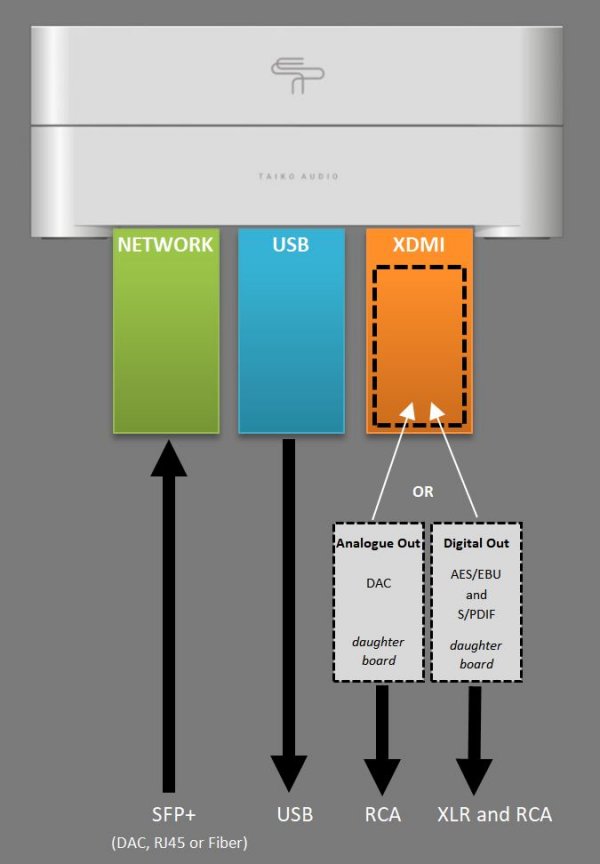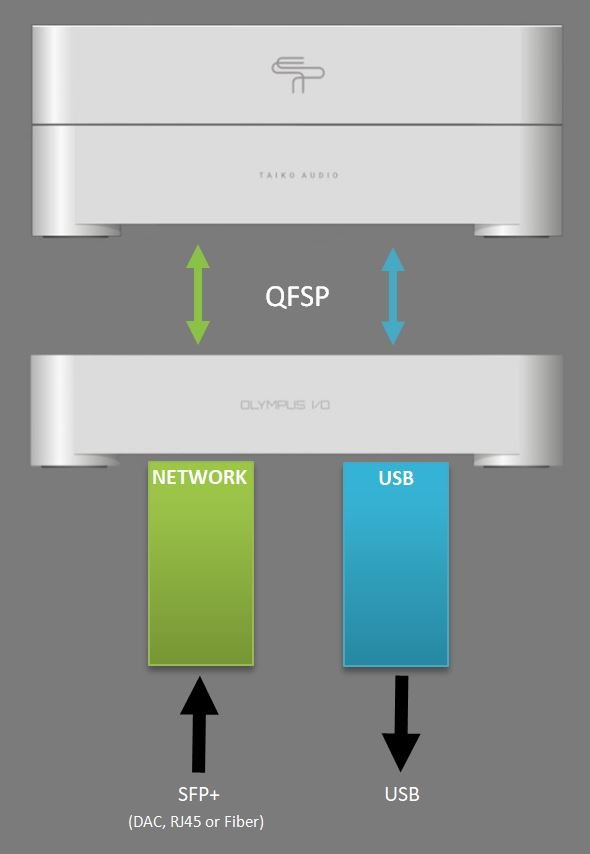Introducing Olympus & Olympus I/O - A new perspective on modern music playback
- Thread starter Taiko Audio
- Start date
You are using an out of date browser. It may not display this or other websites correctly.
You should upgrade or use an alternative browser.
You should upgrade or use an alternative browser.
Can I also ask does Olympus I/o takes 220/110 v for the liner power supply or it gets power from the server?
It will need AC power yes. Both the Olympus and Olympus I/O need AC power, both need a powercord.
Is an “audiophile” power cable of no consequence feeding the battery powered Olympus server and/or IO?
The Olympus has an LPS which powers the motherboard and CPU so I would think that the power cable could have a sonic affect.
Is an “audiophile” power cable of no consequence feeding the battery powered Olympus server and/or IO?
It's always of consequence, it even influences the "sound" of your other components. A common issue in high-end audio is to view everything on a single component level, where every individual component can actually affect every other component in your system.
Agreed, caveats noted. However, in thinking about PCs for the Olympus, if I recall correctly, I think you mentioned that the Audioquest HC Hurricane PC and the Sablon PC (not sure of model) worked well with the Extreme. Are these still recommendations you would endorse for the Olympus or are there others that have since been added to this short list?It's always of consequence, it even influences the "sound" of your other components. A common issue in high-end audio is to view everything on a single component level, where every individual component can actually affect every other component in your system.
Agreed, caveats noted. However, in thinking about PCs for the Olympus, if I recall correctly, I think you mentioned that the Audioquest HC Hurricane PC and the Sablon PC (not sure of model) worked well with the Extreme. Are these still recommendations you would endorse for the Olympus or are there others that have since been added to this short list?
Yeah it works out similarly. I don't spend much time testing power cords or other cabling, I do have a stockpile of cables / tweaks people have send me over time to test, but I never get around to it, more pressing priorities..
Emile, the 2LPS of the Olympus are they going to be similar to the GaN FET DC-DC ATX module? Aren't these in essence switching power supplies/regulators and not linear?Hi @SwissTom , very much appreciate your help in painting an as clear as possible picture.
As we are launching a series of new technologies all packed together in 2 main products it can easily become confusing to the point where it's easy to mix up aspects from individual parts.
Let me therefor start with listing the individual new components / technologies:
1) The Olympus Server utilises the latest available computer hardware with the following differences to the Extreme:
-The Extreme has 2 Intel Xeon Scalable processors with 10 CPU physical CPU cores each for total of 20 physical CPU cores (40 virtual), 48Gb DDR4-2400 Memory, PCIe gen3 interfaces, uses PCIe gen3 M.2 music storage drives and runs Windows 10
- The Olympus has 1 AMD Epyc 4th gen processor with 4*8 physical CPU cores for a total of 32 physical CPU cores (64 virtual), 128Gb DDR5-4800 Memory, PCIe gen5 interfaces, uses MCIO (PCIe) gen5 U.2/U.3 music storage drives and runs Windows 11
2) We are launching new power supply technologies, both linear as battery powered, both are highly power conversion efficient (90% +) and very low noise / transparent, made possible by utilising modern GaN fet technology with our own "twists".
3) We are also launching a new external interface solution utilising high speed (aggregated 112Gbs) QFSP28 cables, this enables the Olympus I/O product. In a nutshell this allows PCIe cards to be placed in an external chassis without the usual drawbacks of such a solution, it even improves performance rather then deteriorating it.
4) Last but not least we are launching our new XDMI music interface. XDMI has an ASIO driver as input, which you can use directly as an output from either Roon or XDMS playback software. This ASIO driver then directly transports the audio bitstream to the XDMI baseboard, over PCIe, where it is converted to I2S, bypassing multiple stages of processing and conversions which are inherent to other protocols. This as as direct a conversion as possible. The XDMI baseboard lastly has a connector which allows connecting the optional output boards, which can either generate a direct analogue output by means of a DAC, or a variety of digital outputs.
-------------------------------------------------
From a practical point of view:
The Olympus server has 4 PCIe slots in which you can mount interface cards.
The Olympus I/O has 2 PCIe slots in which you can mount interface cards.
The Olympus server contains 2 Linear Gan Fet based power supplies and 3 Gan Fet based battery power supplies.
The Olympus I/O contains 1 Linear Gan Fet based power supplies and 2 Gan Fet based battery power supplies.
The Olympus server 5 power supplies are utilised in this way:
1 Linear power supply powers the motherboard/CPU
1 Linear power supply is a battery charger
1 Battery power supply powers the storage drives
1 Battery power supply powers the network interface card
1 Battery power supply powers the output cards (USB and/or XDMI)
The Olympus I/O 3 power supplies are utilised in this way:
1 Linear power supply is a battery charger
1 Battery power supply powers the network interface card + the external interface solution PCIe card
1 Battery power supply powers the output cards (USB or XDMI) + the external interface solution PCIe card
The Olympus server + Olympus I/O stack 8 power supplies are utilised in this way:
On the Olympus server side:
1 Linear power supply powers the motherboard/CPU
1 Linear power supply is a battery charger
1 Battery power supply powers the storage drives
2 Battery power supplies power the external interface solution PCIe cards connecting to the Olympus I/O
On the Olympus I/O side:
1 Linear power supply is a battery charger
1 Battery power supply powers the network interface card + the external interface solution PCIe card
1 Battery power supply powers the output cards (USB or XDMI) + the external interface solution PCIe card
In case this is still unclear, which is completely understandable:
The Olympus server can provide BOTH USB and XDMI as it has enough PCIe expansion slots (4), where the Olympus I/O has 2 PCIe expansion slots and therefor you will have to choose between USB and XDMI, as the other PCIe expansion slot is occupied by the network card.
Again I understand this reads as complete gibberish to many, especially those less versed in computing technologies, it will become much clearer when this actually starts arriving, it's only complicated if you try to understand it without an actual hands-on experience, I think
Emile, the 2LPS of the Olympus are they going to be similar to the GaN FET DC-DC ATX module? Aren't these in essence switching power supplies/regulators and not linear?
Everything switches, linear power supplies are switching, switching power supplies are switching, the difference between them is in their switching frequencies. Low for linear power supplies resulting in "muddy/veiled bass" and "harsh mids", higher for "switching" power supplies resulting in "gray/veiled mids" and "harsh highs". What you are referring to as "switching power supplies / regulators" with harmful side effects for audio applications are harmful because of their specific design. And no there's little resemblance to the technology used in the DC-DC ATX module we offered to the DIY community (2nd gen vs 8th gen), although the 2nd gen is actually already pretty good.
Edit: realising I did not actually answer your question, the supplies are linear in the sense they use an "old fashioned" large transformer operating on low switching frequencies (100/120Hz) in stead of a small transformer operating on high frequencies (usually around 50KHz).
You cannot use all three outputs at the same time.In an Olympus XDMI; can USB, XDMI AES/EBU, and analog all be hot at the same time? If not, what is the switching process?
Trying to understand the possible time delays between A,B,C compares.
You can switch from USB to XDMI via the software.
As for XDMI/Digital and XDMI/Analogue, you'll need to swap the daughterboard, as shown below
Hope it helps.

Last edited:
In an Olympus XDMI; can USB, XDMI AES/EBU, and analog all be hot at the same time? If not, what is the switching process?
Trying to understand the possible time delays between A,B,C compares.
The XDMI interface can support either the AES/EDU/SPDIF or analog, but not at the same time. USB operates on its own. So, you can have USB + XDMI digital or USB + XDMI analog.
Again I understand this reads as complete gibberish to many, especially those less versed in computing technologies, it will become much clearer when this actually starts arriving, it's only complicated if you try to understand it without an actual hands-on experience, I think
Not gibberish - this is quite clear. Every time I think I understand it all, I become re-confused all over again by others posting ‘helpful’ clarification.
Steve Williams
Site Founder, Site Co-Owner, Administrator
i still don’t see from the diagrams where the power switches are. How do you turn on Olympus and IO
Thank you for the responses. So compares would involve software restarts and/or card swaps - so a few minutes between each compare.
The Horizon could facilitate all three inputs simultaneously, switching by remote. Just need (3) Olympuses with all ancillaries running at the same time to feed signal. Money solves all...
The Horizon could facilitate all three inputs simultaneously, switching by remote. Just need (3) Olympuses with all ancillaries running at the same time to feed signal. Money solves all...
i still don’t see from the diagrams where the power switches are. How do you turn on Olympus and IO
The same way as your Extreme.
Thank you for the responses. So compares would involve software restarts and/or card swaps - so a few minutes between each compare.
The Horizon could facilitate all three inputs simultaneously, switching by remote. Just need (3) Olympuses with all ancillaries running at the same time to feed signal. Money solves all...
If money is no object there's 2x Olympus I/O with 2x XDMI
Since both will now have battery power supplies are the power cords as critical as they are to Extreme sonics?It will need AC power yes. Both the Olympus and Olympus I/O need AC power, both need a powercord.
And if so, which one is most important, Olympus or Olympus I/O ?
Swiss Tom , on your diagram I believe also BNC should be added next to "XLR and RCA" below the Digital Out , no ?You cannot use all three outputs at the same time.
You can switch from USB to XDMI via the software.
As for XDMI/Digital and XDMI/Analogue, you'll need to swap the daughterboard, as shown below
Hope it helps.
View attachment 122735
Similar threads
- Replies
- 2
- Views
- 5K
- Sticky
- Replies
- 515
- Views
- 86K
- Replies
- 3
- Views
- 3K
| Steve Williams Site Founder | Site Owner | Administrator | Ron Resnick Site Owner | Administrator | Julian (The Fixer) Website Build | Marketing Managersing |



